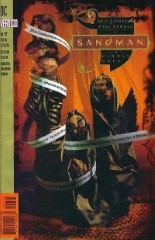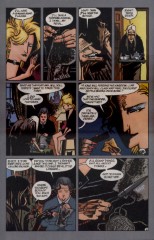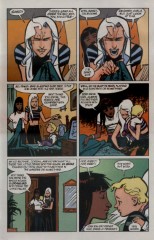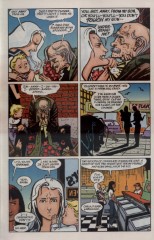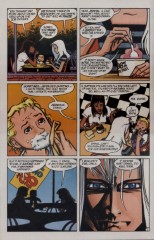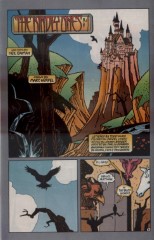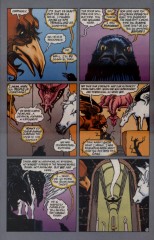Issue 57: "The Kindly Ones: 1"
Neil Gaiman, Marc Hempel
- First part of storyline, The Kindly Ones
- Second story reprinted in trade paperback The Kindly Ones
The Kindly Ones: Translation of Greek "Eumenides". Terrifying hags who pursue those who slay their own kin; really named "Furies", called "kindly" as a euphemism. As with many Greek myths, exact details vary: Aeschylus had a whole chorus of them; other sources number them at exactly three and name them Tisiphone, Alecto, and Megaera. Gaiman follows this version; we see exactly three Furies in Hades in the "Song of Orpheus" -- unsurprising, given the recurring Triple Goddess character. In "Three Septembers and a January" Desire vows to bring the Kindly Ones down on Dream's head (31:21:5), and it's implied in "The Doll's House" that if Dream had killed his great-niece Rose Walker this would have happened. Now Dream has killed his son Orpheus...
Cover: The tape is medieval German; someone identified it as from the Nibelungenlied, the saga that Wagner drew on for his "Ring" cycle.
A note on layout: this arc is dedicated to an aspect of the Triple Goddess; the page layouts are almost entirely based on a six- or nine-panel grid. Six and nine are, of course, multiples of three.
Page 1#
Here we see the Triple Goddess, as we have before, in the aspect of the witches from the old "Witching Hour" series, which is also the aspect of the Fates from Greek myth.
The first panel of each installment of "The Kindly Ones" until the tenth has some sort of thread-like object in it.
Panel 1
The maiden, Clotho, spins the yarn from which lives are woven.
Panel 3
The mother, Lachesis, knits the yarn.
Page 3#
Panel 6
Specifically in 21:2:4. In this, the last long Sandman arc, there are many echoes of the past: old characters return, and things seen before recur. Loose ends are tied up (or snipped off!) as the story draws to a close.
Page 4#
Panel 5
Possibly an echo of the frogs Delirium makes in "Brief Lives" #3 -- 43:10.5.
Panel 6
According to chronological references given elsewhere, Daniel is almost three years old by now. His general appearance and speech patterns are oddly youthful.
Panel 7
The crone, Atropos, cuts the thread of life. There's been speculation about just whose thread was cut: some say Daniel Hall; some say Dream. Perhaps the thread is a metaphor for the story itself: we, the readers, want it to continue indefinitely, but it has to be ended sometime.
Page 5#
Panel 4
An echo: this man looks very similar to Andros, the priest of Orpheus, from "Brief Lives". He even has red flowers such as sprouted where Orpheus' blood touched the ground. It seems rather unlikely that it is actually him, though.
Page 6#
Panel 4
The Baskin-Robbins chain of ice cream stores advertises "31 Flavors". The store Lyta and Carla visit has 57; this may be an amalgamation with Heinz Co.'s "57 varieties" of tomato products. Note that 57 is a multiple of 3 where 31 is not.
Page 7#
Panel 5
Note the 99 on the sign, another multiple of 3.
Panel 6
Foreshadowing -- your key to quality literature.
Page 8#
Panel 1
The title page of each installment of "The Kindly Ones" features a character approaching another's dwelling, frequently after some sort of separation or estrangement. Here Matthew approaches Dream's castle to speak to him.
Page 9#
- This sequence, where Matthew visits each of the characters in the Dreaming in turn, is oddly reminiscent of the story in the "Vertigo Jam".
Page 11#
Panel 3
Note the crescent moon, a female symbol. The women in this story are frequently accompanied by them.
Page 12#
Panel 1
John Webster (1580?-1625?) is best known for the plays "The Duchess of Malfi" and "The White Devil".
Panel 2
Lucien is quoting T.S. Eliot's poem Whispers of Immortality:
"Webster was much possessed by death / And saw the skull beneath the skin; /
And breastless creatures under ground / Leaned backward with a lipless grin."
Page 13#
Panel 4
An echo: the Corinthian played a large role in "The Doll's House". In 14:35.4 Dream said he would remake him.
Page 15#
Panel 6
Aristeas of Marmora -- referenced in Issue 30.
Page 17#
Panel 1
Lux: Latin for "light"; cf. "Lucifer", "Light-Bearer".
Panel 3
Alan Moore's short story "A Hypothetical Lizard" begins, "Half her face was porcelain." Of course, in that story it was the right half, not the left.
Page 18#
Panel 1
Eric Needham is the 'Black Spider' in the DC Universe.
Panel 3
La-La-Land: Los Angeles.
Michael Eisner is head of Disney Studios. Michael Ovitz is a high-powered agent and deal-maker, called "The most powerful man in Hollywood" by Newsweek magazine.
Lucifer, here, has ticked off some more of his Bucket List, having built a house (well, a bar), and learnt to play the piano. No sign of any dancing though.
Panel 4
The song is "These Foolish Things", by Jack Strachey and Eric Maschwitz, English lyrics by Harry Link. A notable line not quoted:
"Oh, how the ghost of you clings."
Page 19#
Panel 7
Before the changes made to DC Universe continuity by the "Crisis on Infinite Earths", Lyta was a character on Earth-2, the daughter of that Earth's Wonder Woman and Steve Trevor. Currently there exists only one Earth, and only one Wonder Woman. Roy Thomas created a new but similar character for the series "The Young All-Stars": the "Golden Age Fury", who received power from the Furies. Current continuity is as given in the next few panels.
Panel 8
The Fury did not wear this costume in "The Young All-Stars".
The couple that adopted her was the superheroine Miss America and an Admiral Steve Trevor, created by Roy Thomas pretty much in order that Lyta could keep the surname "Trevor".
Page 20#
Panel 1
The group was "Infinity, Inc.", and had its own series.
Panel 2
Well, hey. Superheroes lead strange lives.
Page 21#
Panel 2
The return of Lucifer, last seen in issue 28 on an Australian beach. The mute waitress is the demon Mazikeen from issue 23, the half-mask hiding the rotted, skinless horror that is the left half of her face.
Panel 3
The song is actually entitled "Memory". It is based on the poems "Preludes" and "Rhapsody on a Windy Night". Lucifer is clearly a being of highly refined taste.
Panel 6
The song is called "Sit Down, You're Rocking the Boat". It's from the musical "Guys and Dolls"; music and lyrics by Frank Loesser. Two notable lines not quoted:
"And the Devil will drag you under
By the sharp lapel on your checkered coat".
Page 23#
Panel 3
It's winter...rain in L.A. is all but unknown at any other season.
Credits
- Greg "elmo" Morrow (morrow@physics.rice.edu) created the Sandman Annotations. He also referenced Michael Ovitz and corrected some information on Lyta Hall.
- Originally collated and edited by David Goldfarb.
- Demery (demery@prl.philips.nl) referenced Hector Hall's favorite song.
- Katie Schwarz (katie@physics.berkeley.edu) tracked down and translated the script on the cover, noted the oddity of Daniel's development, "57 Flavors", the title-page pattern, and the poems on which "Memory" was based. Sebastian Weinberg (bastian@enterprise.mathematik.uni-essen.de) corrected the cover script translation.
- Keith Kole, as reported by Joel Finkle (jjfink@skcla.monsanto.com) noticed the first-panel pattern.
- Michele Tepper (misha@umich.edu) referenced the Eliot poem; so did Steven Zwanger (szwanger@panix.com), Paul O'Brien (prob@festival.ed.ac.uk), and Doug Noble (D.NOBLE@dundee.ac.uk)
- Ralf Hildebrandt added more details.
- Richard Munn added the note about Eric Needham's identity, and Lucifer's bucket list.
Last modified by Richard Munn on 2023-08-21 - Fixed some formatting, and improved blockstyle plugin behaviour
[edit this page] [page history]
